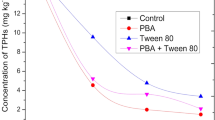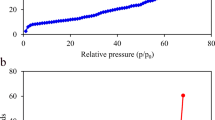Abstract
Solubilizing experiments were carried out to evaluate the ability of biodiesel to remove polycyclic aromatic hydrocarbons (PAHs) from highly contaminated manufactured gas plant (MGP) and PAHs spiked soils with hydroxypropyl-β-cyclodextrin (HPCD) and tween 80 as comparisons. Biodiesel displayed the highest solubilities of phenanthrene (420.7 mg·L−1), pyrene (541.0 mg·L−1), and benzo(a)pyrene (436.3 mg·L−1). These corresponded to several fold increases relative to 10% HPCD and tween 80. Biodiesel showed a good efficiency for PAH removal from the spiked and MGP soils for both low molecular weight and high molecular weight PAHs at high concentrations. Biodiesel was the best agent for PAH removal from the spiked soils as compared with HPCD and tween 80; as over 77.9% of individual PAH were removed by biodiesel. Tween 80 also showed comparable capability with biodiesel for PAH solubilization at a concentration of 10% for the spiked soils. Biodiesel solubilized a wider range of PAHs as compared to HPCD and tween 80 for the MPG soils. At PAH concentrations of 229.6 and 996.9 mg·kg−1, biodiesel showed obvious advantage over the 10% HPCD and tween 80, because it removed higher than 80% of total PAH. In this study, a significant difference between PAH removals from the spiked and field MGP soils was observed; PAH removals from the MGP soil by HPCD and tween 80 were much lower than those from the spiked soil. These results demonstrate that the potential for utilizing biodiesel for remediation of highly PAH-contaminated soil has been established.
Similar content being viewed by others
References
Haritash A K, Kaushik C P. Biodegradation aspects of polycyclic aromatic hydrocarbons (PAHs): a review. Journal of Hazardous Materials, 2009, 169(1–3): 1–15
Hawthorne S B, Poppendieck D G, Grabanski C B, Loehr R C. Comparing PAH availability from manufactured gas plant soils and sediments with chemical and biological tests. 1. PAH release during water desorption and supercritical carbon dioxide extraction. Environmental Science & Technology, 2002, 36(22): 4795–4803
Tao S, Cui Y H, Xu F L, Li B G, Cao J, Liu W X, Schmitt G, Wang X J, ShenWR, Qing B P, Sun R. Polycyclic aromatic hydrocarbons (PAHs) in agricultural soil and vegetables from Tianjin. The Science of the Total Environment, 2004, 320(1): 11–24
Karimi-Lotfabad S K, Pickard M A, Gray M R. Reactions of polynuclear aromatic hydrocarbons on soil. Environmental Science & Technology, 1996, 30(4): 1145–1151
Teng Y, Luo Y M, Ping L F, Zou D X, Li Z G, Christie P. Effects of soil amendment with different carbon sources and other factors on the bioremediation of an aged PAH-contaminated soil. Biodegradation, 2010, 21(2): 167–178
Johnsen A R, Wick L Y, Harms H. Principles of microbial PAH-degradation in soil. Environmental Pollution, 2005, 133(1): 71–84
Berselli S, Milone G, Canepa P, Di Gioia D, Fava F. Effects of cyclodextrins, humic substances, and rhamnolipids on the washing of a historically contaminated soil and on the aerobic bioremediation of the resulting effluents. Biotechnology and Bioengineering, 2004, 88(1): 111–120
Lei A P, Hu Z L, Wong Y S, Tam N F Y. Removal of fluoranthene and pyrene by different microalgal species. Bioresource Technology, 2007, 98(2): 273–280
Hong Y W, Yuan D X, Lin Q M, Yang T L. Accumulation and biodegradation of phenanthrene and fluoranthene by the algae enriched from a mangrove aquatic ecosystem. Marine Pollution Bulletin, 2008, 56(8): 1400–1405
Ehsan S, Prasher S O, Marshall W D. Simultaneous mobilization of heavy metals and polychlorinated biphenyl (PCB) compounds from soil with cyclodextrin and EDTA in admixture. Chemosphere, 2007, 68(1): 150–158
Khodadoust A P, Bagchi R, Suidan M T, Brenner R C, Sellers N G. Removal of PAHs from highly contaminated soils found at prior manufactured gas operations. Journal of Hazardous Materials, 2000, 80(1–3): 159–174
Zhao B, Zhu L, Li W, Chen B. Solubilization and biodegradation of phenanthrene in mixed anionic-nonionic surfactant solutions. Chemosphere, 2005, 58(1): 33–40
Han M, Ji G, Ni J. Washing of field weathered crude oil contaminated soil with an environmentally compatible surfactant, alkyl polyglucoside. Chemosphere, 2009, 76(5): 579–586
Khodadoust A P, Reddy K R, Maturi K. Effect of different extraction agents on metal and organic contaminant removal from a field soil. Journal of Hazardous Materials, 2005, 117(1): 15–24
Chu W. Remediation of contaminated solid by surfactant-aided soil washing. Practice Periodical of Hazardous Toxic and Radioactive Waste Management, 2003, 7(1): 19–24
Tungittiplakorn W, Cohen C, Lion L W. Engineered polymeric nanoparticles for bioremediation of hydrophobic contaminants. Environmental Science & Technology, 2005, 39(5): 1354–1358
Khodadoust A, Reddy K, Maturi K. Removal of phenanthrene from kaoilin soil using different extractants. Environmental Engineering Science, 2004, 21(6): 691–704
Khalladi R, Benhabiles O, Bentahar F, Moulai-Mostefa N. Surfactant remediation of diesel fuel polluted soil. Journal of Hazardous Materials, 2009, 164(2–3): 1179–1184
Jozefaciuk G, Muranyi A, Fenyvesi E. Effect of randomly methylated beta-cyclodextrin on physical properties of soils. Environmental Science & Technology, 2003, 37(13): 3012–3017
Tick G R, Lourenso F, Wood A L, Brusseau M L. Pilot-scale demonstration of cyclodextrin as a solubility-enhancement agent for remediation of a tetrachloroethene-contaminated aquifer. Environmental Science & Technology, 2003, 37(24): 5829–5834
Viglianti C, Hanna K, de Brauer C, Germain P. Removal of polycyclic aromatic hydrocarbons from aged-contaminated soil using cyclodextrins: experimental study. Environmental Pollution, 2006, 140(3): 427–435
von Wedel R. Cytosol-cleaning oiled shorelines with a vegetable oil biosolvent. Spill Science & Technology Bulletin, 2000, 6(5–6): 357–359
Yap C L, Gan S, Ng H K. Application of vegetable oils in the treatment of polycyclic aromatic hydrocarbons-contaminated soils. Journal of Hazardous Materials, 2010, 177(1–3): 28–41
Gao S, Wang L, Huang Q, Han S. Solubilization of polycyclic aromatic hydrocarbons by β-cyclodextrin and carboxymethyl-β-cyclodextrin. Chemosphere, 1998, 37(7): 1299–1305
Ko S, Schlautman M, Carraway E. Partitioning of hydrophobic organic compound to hydroxypropyl-a-cyclodextrin: experimental studies and model predictions for surfactant-enhanced remediation applications. Environmental Science & Technology, 1999, 33(16): 2765–2770
Gómez J, Alcántara M T, Pazos M, Sanromán M A. Remediation of polluted soil by a two-stage treatment system: desorption of phenanthrene in soil and electrochemical treatment to recover the extraction agent. Journal of Hazardous Materials, 2010, 173(1–3): 794–798
Alcántara M T, Gómez J, Pazos M, Sanromán M A. PAHs soil decontamination in two steps: desorption and electrochemical treatment. Journal of Hazardous Materials, 2009, 166(1): 462–468
Cheng K Y, Wong J W C. Combined effect of nonionic surfactant Tween 80 and DOM on the behaviors of PAHs in soil—water system. Chemosphere, 2006, 62(11): 1907–1916
West C C, Harwell J H. Surfactants and subsurface remediation. Environmental Science & Technology, 1992, 26(12): 2324–2330
McBride M B, Pitiranggon M, Kim B. A comparison of tests for extractable copper and zinc in metal-spiked and field-contaminated soil. Soil Science, 2009, 174(8): 439–444
Oorts K, Bronckaers H, Smolders E. Discrepancy of the microbial response to elevated copper between freshly spiked and long-term contaminated soils. Environmental Toxicology and Chemistry, 2006, 25(3): 845–853
Fernández-Álvarez P, Vila J, Garrido J M, Grifoll M, Feijoo G, Lema J M. Evaluation of biodiesel as bioremediation agent for the treatment of the shore affected by the heavy oil spill of the Prestige. Journal of Hazardous Materials, 2007, 147(3): 914–922
Juhasz A L, Smith E, Weber J, Naidu R, Rees M, Rofe A, Kuchel T, Sansom L. Effect of soil ageing on in vivo arsenic bioavailability in two dissimilar soils. Chemosphere, 2008, 71(11): 2180–2186
Taylor L T, Jones D M. Bioremediation of coal tar PAH in soils using biodiesel. Chemosphere, 2001, 44(5): 1131–1136
Miller N J, Mudge S M. The effect of biodiesel on the rate of removal and weathering characteristics of crude oilwithin artificial sand columns. Spill Science & Technology Bulletin, 1997, 4(1): 17–33
Author information
Authors and Affiliations
Corresponding author
Rights and permissions
About this article
Cite this article
Wu, J., Gong, Z., Zheng, L. et al. Removal of high concentrations of polycyclic aromatic hydrocarbons from contaminated soil by biodiesel. Front. Environ. Sci. Eng. China 4, 387–394 (2010). https://doi.org/10.1007/s11783-010-0269-z
Received:
Accepted:
Published:
Issue Date:
DOI: https://doi.org/10.1007/s11783-010-0269-z




